
 Windrow composting is
being successfully used at full scale to remediate soils contaminated with high explosives
(HE) as part of the Pantex Plant Environmental
Restoration (ER) Project in Amarillo, Texas. The project (OST/TMS ID 1529), supported by Accelerated Site Technology Deployment, involves
systematic soil removal and treatment to decrease the HE concentration to a nonhazardous
level. Subsequently, the soil is disposed of in Pantex’ on-site Environmental
Landfill Cell. Windrow composting is
being successfully used at full scale to remediate soils contaminated with high explosives
(HE) as part of the Pantex Plant Environmental
Restoration (ER) Project in Amarillo, Texas. The project (OST/TMS ID 1529), supported by Accelerated Site Technology Deployment, involves
systematic soil removal and treatment to decrease the HE concentration to a nonhazardous
level. Subsequently, the soil is disposed of in Pantex’ on-site Environmental
Landfill Cell.
The Pantex Plant manufactured conventional weapons during World War II and subsequently
converted to the assembly and disassembly of nuclear weapons. Scrap HE and HE-contaminated
components generated during these processes were dispositioned through controlled
detonation and burning at the Pantex Burning Grounds, leaving soils contaminated with HE
and barium nitrate.
 The
windrow composting facility consists of two 270-foot-long modular structures, each with
the capacity to house three windrows (so called because the long mound shape resembles hay
raked in preparation for baling). Each windrow treats approximately 100 cubic yards of
contaminated soil at a time. Key factors contributing to the design and construction of
the project were effectiveness and cost, so basic goals were identifying optimal
amendments and using easily obtainable and relatively inexpensive resources. The project
adopted several strategies to meet these goals: The
windrow composting facility consists of two 270-foot-long modular structures, each with
the capacity to house three windrows (so called because the long mound shape resembles hay
raked in preparation for baling). Each windrow treats approximately 100 cubic yards of
contaminated soil at a time. Key factors contributing to the design and construction of
the project were effectiveness and cost, so basic goals were identifying optimal
amendments and using easily obtainable and relatively inexpensive resources. The project
adopted several strategies to meet these goals:
- procuring locally available equipment to construct the modular
facility;
- using locally available materials for composting, such as steer manure from a local
feedyard and second-cycle wood chips from a municipal composting
operation;
- adding mycelium from white rot and other fungi to increase the efficiency of HE
mineralization; and
- using sulfate-based fertilizers as terminal electron acceptors for microbial metabolism
and chemically converting soluble barium to relatively insoluble barium sulfate.
 Jay Childress,
the ER Soil Remediation Section manager responsible for the Pantex HE Composting
Technology project, says, "By March 2000, we treated about 3,500 cubic yards of
HE-contaminated soil. The cost of composting is about $82 per cubic yard, compared with
somewhere around $396 per cubic yard for disposing of the soil as Class I waste. Using
this technology, we estimate that we saved DOE over a million dollars." Jay Childress,
the ER Soil Remediation Section manager responsible for the Pantex HE Composting
Technology project, says, "By March 2000, we treated about 3,500 cubic yards of
HE-contaminated soil. The cost of composting is about $82 per cubic yard, compared with
somewhere around $396 per cubic yard for disposing of the soil as Class I waste. Using
this technology, we estimate that we saved DOE over a million dollars."
The clear reduction in treatment, disposal, and transportation costs has prompted plans
for expanded application of this innovative technology in FY 2001. Plans are under way to
compost the approximately 10,000 cubic yards of contaminated soil contained in ditches on
the Pantex site. Also, as a result of the demonstrated savings, export of the technology
to other DOE sites such as Los Alamos National Laboratory
is being considered for curbing long-term liability costs for the DOE Environmental Restoration Program.
For more information on the Pantex HE Composting
Technology Project, contact Martin Amos at (806) 477-6458, mamos@pantex.com.
|

 Windrow composting is
being successfully used at full scale to remediate soils contaminated with high explosives
(HE) as part of the
Windrow composting is
being successfully used at full scale to remediate soils contaminated with high explosives
(HE) as part of the  The
windrow composting facility consists of two 270-foot-long modular structures, each with
the capacity to house three windrows (so called because the long mound shape resembles hay
raked in preparation for baling). Each windrow treats approximately 100 cubic yards of
contaminated soil at a time. Key factors contributing to the design and construction of
the project were effectiveness and cost, so basic goals were identifying optimal
amendments and using easily obtainable and relatively inexpensive resources. The project
adopted several strategies to meet these goals:
The
windrow composting facility consists of two 270-foot-long modular structures, each with
the capacity to house three windrows (so called because the long mound shape resembles hay
raked in preparation for baling). Each windrow treats approximately 100 cubic yards of
contaminated soil at a time. Key factors contributing to the design and construction of
the project were effectiveness and cost, so basic goals were identifying optimal
amendments and using easily obtainable and relatively inexpensive resources. The project
adopted several strategies to meet these goals: Jay Childress,
the ER Soil Remediation Section manager responsible for the Pantex HE Composting
Technology project, says, "By March 2000, we treated about 3,500 cubic yards of
HE-contaminated soil. The cost of composting is about $82 per cubic yard, compared with
somewhere around $396 per cubic yard for disposing of the soil as Class I waste. Using
this technology, we estimate that we saved DOE over a million dollars."
Jay Childress,
the ER Soil Remediation Section manager responsible for the Pantex HE Composting
Technology project, says, "By March 2000, we treated about 3,500 cubic yards of
HE-contaminated soil. The cost of composting is about $82 per cubic yard, compared with
somewhere around $396 per cubic yard for disposing of the soil as Class I waste. Using
this technology, we estimate that we saved DOE over a million dollars."